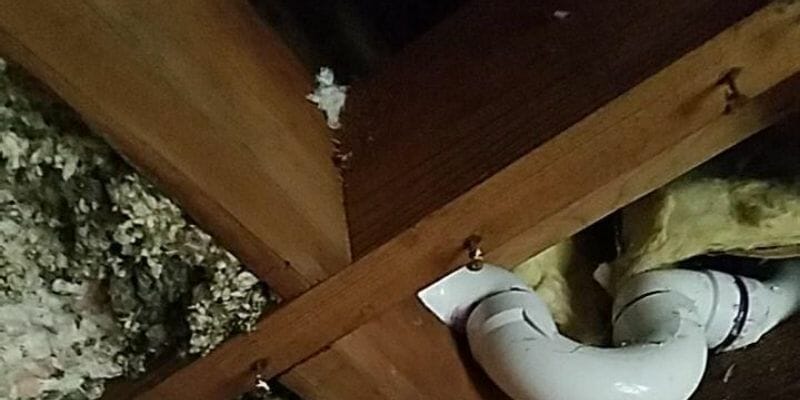By the time you realize there’s a slow leak in the attic, it’s already affected stored belongings, insulation, ductwork and joists. A broken pipe up in the attic can quickly result in dangerous ceiling damage as leaking water soaks walls, floors and furnishings in the rooms below.
Regardless of the cause, it’s never easy to deal with attic water damage and the soggy aftermath. Still, there are several important steps you need to take as quickly as possible.
Over the years, we’ve helped thousands of Chicago homeowners with water in the attic. We’re happy to share our expertise and insider tips so that you know what to do when your attic leaks.
Common Causes of Water Leaks in the Attic

Most attic leaks happen because of problems on the roof. Damaged shingles, loose flashing and bad sheathing are just a few examples. The weather takes a toll too. Freezing temperatures create ice dams along roof edges that back up melting snow under shingles and into the attic.
Broken water pipes, heavy condensation and AC leaks in the attic can also result in serious water damage to your home. Knowing what to look for makes it easier to identify the type of leak.
Signs of a Roof Leak in the Attic
- Discolored attic ceiling materials
- Mold growth in areas below roof valleys
- Damp walls adjacent to gutters and downspouts
- Moisture accumulated around and under attic vents
Signs of Pipe Leaks in the Attic
- Corrosion and rust on attic pipes
- Water stains on attic floor surfaces
- Stains around downstairs ceiling light fixtures
Signs of Attic Condensation Problems
- Damp attic walls and flooring
- Buckled ceiling materials
- Excessive attic humidity
- Pervasive musty odors
What to Do When You Have Water Damage in the Attic

Figuring out how to clean up attic water damage can be a challenge. Using a headlamp flashlight makes the work safer by illuminating spaces and freeing up your hands. It’s important to understand that this may not be a DIY project. Follow these steps, but be ready to bring in water damage professionals to finish the job.
1. Identify the Attic Leak Source
Water coming in from the roof usually leaves trails on overhead joists. Track drips or moisture upward as you look for the leak. Burst pipes in the attic should be easy to locate, but different types of insulation can make the work harder. If attic surfaces feel damp, the problem could be accumulated condensation.
2. Take Care of Initial Cleanup
Once you’re sure that you’ve found the leak, be careful with initial cleanup. Water in the attic can weaken support joists and the surfaces you walk on. Remove any stored belongings, clean up standing water, and check the extent of damages. Look for mold growth, rotted wood and soggy insulation.
3. Address Necessary Repairs
Attic leak repairs on the roof might range from replacing damaged shingles to cleaning out gutters. You can often fix a pipe leak with plumber’s putty, pipe tape or a C-clamp. Controlling condensation in the attic usually requires installing vapor barriers and improving ventilation. You may want to call in a licensed roofer or plumber to take care of repairs.
4. Finish With Replacements and Remediation
Replace soggy insulation and damaged walking surfaces. If your AC was the source of leaks in the attic, call in an HVAC technician to handle necessary repairs or replacements. It’s very difficult to eliminate mold in the attic. Leave this job to a restoration company that specializes in mold removal and remediation.
How to Deal with Mold in the Attic From Roof Leaks

A wet attic creates an ideal environment for mold growth. Many types of fungal species thrive in the damp space, especially during warm weather. As it spreads, mold invades stored items, insulation, wood joists and ductwork.
Getting rid of mold in a leaky attic isn’t a DIY project. We strongly advise calling industry professionals who specialize in this type of hazardous cleanup.
Let certified mold removal technicians like ServiceMaster Restoration by Zaba in Chicago take care of the work with equipment and products that eliminate attic mold and protect the health of everyone in your home.
How to Prevent Leaks in the Attic
After finding and repairing an attic leak, you want to make sure it doesn’t happen again. These simple tips can minimize the risk of leaks and water damage in your attic.
- Keep gutters and downspouts clean and in good condition.
- Regularly check the roof for loose shingles and damaged flashing.
- Inspect attic vents, and keep them clear of any blockage.
- Replace insulation that’s become flat, stiff or damp.
- Install vapor barriers to reduce attic condensation.
- Vent appliance exhausts directly outside instead of through the attic.
- Head off AC leaks in the attic with professional HVAC maintenance.
- Increase attic air circulation by leaving all room air vents open.
If you bring in restoration professionals to dry out the attic, ask the technicians for pointers. They can help you solve all types of problems. For example, they know how to remove water damage on attic sheathing. Restoration pros can often salvage soaked belongings, and they can help you navigate your water damage claims process.
Dealing with Attic Water Damage in Chicago, IL? We Can Help!

Most attic water damage cleanup jobs are too big for Chicagoland homeowners. Water removal, cleanup and restoration need to be handled by industry-certified specialists. We offer a full line of water damage cleanup services, including mold removal and complete property restoration.
Don’t let a leak in your attic turn into a homeowner’s nightmare. Our teams here at ServiceMaster by Zaba are just around the corner with expert attic cleanup services. We’re ready for your call: 773-647-1985
The post Leak in the Attic? Here’s What to Do Right Now appeared first on ServiceMaster Restoration by Zaba.
source https://www.servicemasterbyzaba.com/blog/leak-in-attic/
No comments:
Post a Comment